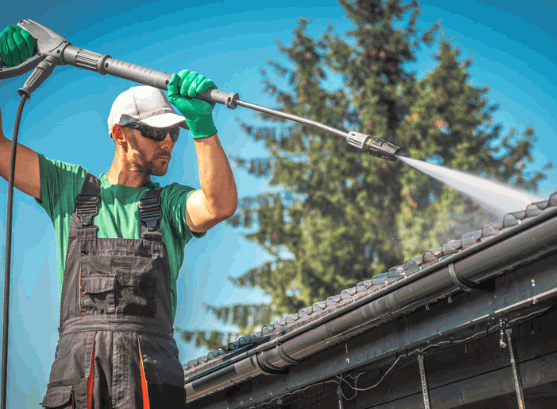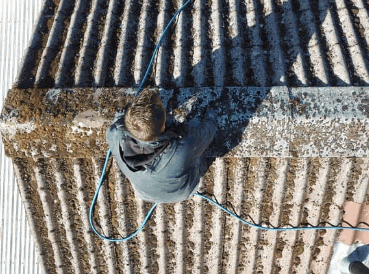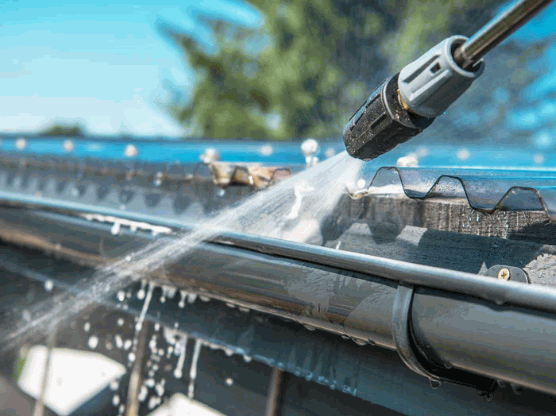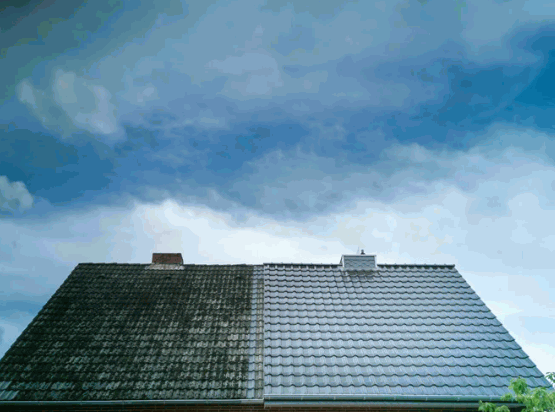
Maintaining a clean roof is essential for both the longevity and aesthetics of a home, ensuring effective roof maintenance and moss removal. Roof cleaning not only improves curb appeal but also prevents damage caused by harmful moss, algae growth, and roof debris. This article examines the components of roof cleaning, its importance, and the various cleaning methods available for implementation. It addresses the risks associated with neglecting this critical maintenance task, outlines necessary safety precautions, and evaluates the decision of whether to undertake the task independently or to engage a professional service. Additionally, it provides information on the indicators that suggest a roof requires attention and offers guidance on selecting the most suitable cleaning service to meet individual needs, including consultation with cleaning professionals.

Table of Contents
Roof cleaning is an essential procedure that entails the removal of debris, moss, and algae from various types of roofing materials, including asphalt shingles, clay tiles, and concrete tiles. Regular maintenance of the roof not only enhances its aesthetic appeal but also extends its lifespan, thereby safeguarding the investment made in the property.
The methods employed for cleaning may differ, utilizing techniques such as soft wash cleaning and pressure washing to effectively eliminate undesired growth and debris. Homeowners in areas susceptible to algae growth, such as South Florida, should incorporate routine roof cleaning into their comprehensive home maintenance strategy.
Look into: What Are The Types Of Roofs
Roof cleaning is essential for preventing algae growth, which not only detracts from the appearance of the roof but can also result in damage over time. Regular maintenance enhances both the aesthetics and longevity of the roof while improving its overall performance.
Engaging professional cleaning services for roof inspection and maintenance ensures that the roof remains in optimal condition, thereby safeguarding the structural integrity of the home. Homeowners who neglect roof cleaning may encounter increased roof cleaning costs due to potential damage that could necessitate more extensive repairs.

The advantages of roof cleaning are numerous, encompassing improved aesthetics, increased roof longevity, and enhanced efficiency of roofing systems. By utilizing effective cleaning solutions and products, homeowners can maintain the pristine appearance of their roofs while preventing damage caused by moss and algae growth. Regular maintenance not only prolongs the lifespan of roofing materials but also preserves the energy efficiency of the home, leading to reduced utility costs. Engaging professional cleaning services further enhances the effectiveness of the cleaning process.
A clean roof significantly enhances the overall appearance of a home, making it more inviting and appealing to visitors or potential buyers. Homeowners have various cleaning methods to choose from, including:
Products such as sodium hypochlorite or eco-friendly alternatives are effective in eliminating stubborn growth. Hiring professionals ensures a thorough cleaning while also facilitating the early detection of potential issues, ultimately saving time and money on long-term repairs.
Protecting investments in roofing not only enhances property value but also provides peace of mind for households.
Neglecting roof cleaning can result in a multitude of issues, including damage to the roof caused by algae growth and the accumulation of debris. Over time, these complications can jeopardize roof safety and necessitate expensive repairs or even complete roof replacement. Furthermore, homeowners may discover that their roof warranty becomes void if they do not maintain their roofs properly, highlighting the critical importance of regular inspections and maintenance services. Failure to address roof cleaning can ultimately impact the overall structural integrity of the home.
When homeowners underestimate the necessity of maintaining clean roofs, they inadvertently elevate the risk of serious problems that can worsen over time due to inadequate roof care. Algae and moss thrive in damp conditions, which can lead to:
Additionally, it is essential to recognize that neglecting roof maintenance can compromise the structure of the home, as weakened roofs pose significant safety risks.
Adopting a proactive approach that includes regular inspections and scheduled maintenance services not only reduces potential risks but also ensures that warranties remain valid. Homeowners are encouraged to engage professionals who can effectively evaluate and address their roofing needs thereby ensuring peace of mind for the future.

Homeowners have several effective methods for roof cleaning that can help maintain their roofs in optimal condition. These methods include pressure washing, chemical cleaning, and manual scrubbing. Each approach offers distinct advantages and is suitable for various types of roofing materials and conditions.
For instance, pressure washing is proficient at removing loose debris; however, it may not be appropriate for all roof types. Chemical cleaning employs specific agents designed to effectively target moss and algae growth, while manual scrubbing may be necessary for localized areas that require additional attention.
A thorough understanding of these methods is essential for homeowners seeking to enhance both the longevity and appearance of their roofs.
Pressure washing is recognized as one of the most effective methods for cleaning roofs, and efficiently removing dirt, debris, and moss. This technique employs high-pressure water jets to dislodge contaminants from the roof surface, making it particularly suitable for flat roofs and those with significant debris accumulation.
However, it is essential to exercise caution, as excessive pressure can potentially damage certain roofing materials. This highlights the importance of implementing proper cleaning techniques to optimize cleaning efficiency without compromising the integrity of the roof.
This method presents several advantages that contribute to the maintenance of the roof's longevity and aesthetic appeal. By effectively eliminating algae, lichens, and other organic growths, pressure washing significantly enhances the overall appearance of the property. Key benefits include:
Despite its advantages, it is crucial to acknowledge the potential cleaning risks associated with pressure washing. Pressure levels must be adjusted according to the specific roofing material; for instance, softer materials such as asphalt shingles require lower pressure to prevent granule loss and damage.
Therefore, understanding the type of roofing and employing appropriate techniques is paramount to enhancing safety and effectiveness in any roof cleaning project.

Chemical cleaning is a method that employs specific cleaning agents and biocide treatments designed to eradicate algae and moss from roofs. This approach is particularly effective in addressing persistent growths that are resistant to removal through physical means.
A variety of specialized formulations are available, ranging from alkaline cleaners to biological agents that not only eliminate algae and moss but also offer residual protection against future infestations. These products perform optimally, particularly when applied during warm, dry conditions.
To achieve the best results, it is essential to adhere to specific application techniques:
Prioritizing environmental safety is crucial when employing chemical agents; therefore, selecting eco-friendly products or implementing effective runoff control measures can help mitigate negative impacts on landscaping and adjacent water sources.

Manual scrubbing is a meticulous roof cleaning technique that involves the physical removal of debris and biological growth using brushes or scrubbers. This method is particularly advantageous for roofs composed of delicate materials, where high-pressure washing could potentially cause damage. Consequently, it is often the preferred choice among cleaning professionals and roof cleaning companies aiming to restore the aesthetic appearance of roofs. Although manual scrubbing can be labor-intensive, it facilitates a thorough cleaning process as well as an opportunity to examine the roof for any signs of damage or wear that may necessitate further attention. Roof cleaning safety is paramount during this process.
Plus its careful application on sensitive roofing materials, this traditional method offers numerous benefits, making it a favored option in specific scenarios, particularly in roof transformation and improving roof aesthetics.
During the cleaning process, it is essential to conduct a comprehensive inspection to identify any potential issues, such as loose tiles or rusted fixtures, ensuring that the roof not only maintains an attractive appearance but also remains durable and functional for years to come. Roof inspection services can help in identifying these issues efficiently.

Safety precautions are critical in roof cleaning to prevent accidents and injuries while maintaining the integrity of the roof. The use of appropriate equipment and protective gear, including harnesses and non-slip footwear, is essential for anyone engaged in roof maintenance activities. Roof cleaning safety protocols should always be followed.
Furthermore, homeowners are encouraged to hire cleaning professionals who are trained in roof safety protocols and can conduct a comprehensive inspection of the roof prior to initiating the cleaning process. A thorough understanding of the risks associated with roof cleaning can significantly mitigate the likelihood of accidents. It's advisable to seek homeowner education on these safety measures.
Utilizing proper equipment and protective gear is essential for ensuring safety during roof cleaning operations. Key tools include harnesses, ladders equipped with stabilizers, and non-slip footwear to mitigate the risk of falls and injuries. Cleaning professionals should also be equipped with safety goggles and gloves to safeguard against chemical exposure when handling cleaning products. Investing in the appropriate equipment not only enhances safety but also improves overall cleaning efficiency. Roof cleaning solutions should be selected carefully to avoid roof damage.
When undertaking a roof cleaning project, it is crucial to understand the various types of equipment required. It is advisable to use heavy-duty pressure washers for effective removal of dirt and moss, and to ensure that the ladders employed are both sturdy and of suitable height. Roof cleaning techniques should be adapted to the specific roof conditions.
A roof rake can be instrumental in safely clearing debris from the ground, thereby minimizing the risk of accidents. Homeowners should also consider the use of protective equipment, such as hard hats, particularly when employing high-pressure cleaning methods, as flying debris can pose significant hazards. Gutter cleaning should also be a part of the overall roof maintenance plan to ensure the roof's longevity.
It is imperative for both homeowners and professionals to be proactive in implementing these safety measures, as they can significantly impact not only safety but also the overall success of the cleaning endeavor.

Collaboration in pairs is an essential safety measure in roof cleaning, as it enhances team coordination and reduces the risks associated with working at heights. Having a partner ensures that assistance is readily available in the event of an emergency, facilitating an immediate response to accidents or injuries. Cleaning professionals often emphasize the importance of teamwork during roof inspection and maintenance, which contributes to a safer working environment and allows team members to support one another throughout the cleaning process. This approach also increases roof cleaning effectiveness.
By working collaboratively, individuals can effectively address various tasks, such as identifying potential repair areas, safely maneuvering equipment, and distributing physical burdens. This partnership not only promotes a more efficient workflow but also encourages shared vigilance, enabling one team member to monitor the other's position and stability. For instance, during a roof cleaning operation, one professional may concentrate on removing debris while their partner stands by to ensure stability and provide additional support. This method improves overall roof cleaning systems.
Ultimately, partnering during roof cleaning not only promotes safer practices but also contributes to a more thorough and effective cleaning experience.

Before initiating any roof cleaning activities, it is imperative to assess for electrical hazards that may present significant risks. This assessment includes inspecting power lines, antennas, and other nearby electrical installations that could create dangerous situations. Cleaning professionals prioritize safety by conducting comprehensive roof inspections to identify potential hazards, thereby ensuring that all necessary precautions are implemented to mitigate risks associated with working in proximity to electricity. Homeowners should also be aware of the roof cleaning problems that could arise from such hazards.
Understanding the presence and proximity of electrical sources is crucial. While a clean roof can greatly enhance a property's aesthetic appeal, neglecting electrical hazards could result in severe consequences. Roof algae removal is also critical to maintaining a clean and safe roof. The following guidelines should be considered to effectively inspect for potential hazards prior to cleaning:
Cleaning professionals also recommend adhering to specific safety measures, such as:
By following these safety measures, individuals can significantly reduce their risk of encountering electrical hazards during roof cleaning.

The frequency of roof cleaning is influenced by several factors, including the type of roofing material, local climate conditions, and the prevalence of algae growth in the vicinity. Regular cleaning frequency helps maintain the roof's integrity.
It is generally recommended to schedule roof maintenance and cleaning at least once a year to prevent the accumulation of debris and potential damage. Regular roof inspections can aid in identifying any signs of deterioration or the need for cleaning, thereby helping to keep cleaning costs manageable and ensuring that the roof remains in optimal condition. Considering a cleaning service provider can ensure thorough and professional roof treatment.
Identifying the indicators that a roof requires cleaning is crucial for preserving its aesthetic appeal and preventing potential damage. Common signs include visible algae growth (such as Gloeocapsa magma), the presence of moss, and the accumulation of debris, all of which can undermine the roof's functionality and appearance.
Homeowners should perform regular inspections of their roofs to detect these signs early on, facilitating timely cleaning and maintenance measures that can significantly prolong the lifespan of the roofing material. Engaging with roof cleaning systems can also help in maintaining the roof's quality.

Determining whether to undertake roof cleaning independently or to engage a professional service necessitates a careful evaluation of the associated risks and benefits of each option. Consulting with experts from organizations like the National Roofing Contractors Association can provide valuable insights.
While performing the cleaning oneself may offer cost savings, it can also introduce substantial safety risks, particularly for individuals lacking experience or the appropriate equipment. Professional cleaners possess the requisite tools and expertise to conduct comprehensive roof inspections and cleaning, while effectively minimizing potential hazards.
Homeowners should assess their own abilities and the inherent risks before making a decision, ensuring that their roof is properly maintained without compromising safety. Entities like the Asphalt Roofing Manufacturers Association can offer guidelines on best practices for roof cleaning.
The costs associated with roof cleaning can vary considerably based on several factors, including the size of the roof, the type of roofing material, and the cleaning method utilized. Homeowners can generally anticipate that professional cleaning services will be priced according to the complexity of the task and any supplementary maintenance services that may be necessary. Amy Freeman, an expert in exterior cleaning, suggests obtaining multiple quotes to understand the cost variability.
It is advisable for homeowners to familiarize themselves with the potential costs involved and to obtain multiple estimates to ensure they receive fair pricing without compromising the quality of the cleaning service providers.

Selecting an appropriate roof cleaning company is crucial for ensuring high-quality services and effective roof maintenance. Homeowners should take into account several factors, including the company's experience and affiliation with organizations like the National Roofing Contractors Association, reputation, particularly in regions like South Florida, the cleaning solutions, especially those effective against Gloeocapsa magma they offer, and whether they provide comprehensive roof inspection services.
Engaging professionals who employ suitable cleaning techniques and products can have a significant impact on the longevity and aesthetics of the roof. Therefore, conducting thorough research prior to making a selection is essential.